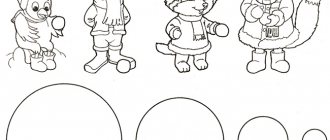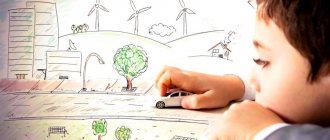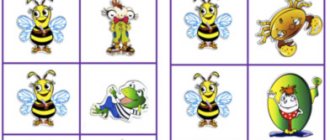"Me and my health." Valeological games and exercises
According to the World Health Organization, “health is a state of complete physical, mental and social well-being and not merely the absence of disease or injury.”
A number of factors influence a child’s health:
- heredity (share of influence is 20%)
- environmental impact (share of influence - 20%)
- medical care (share of influence - 10%)
- lifestyle (share of influence - 50%).
These data force us to pay the most serious attention to the fourth group of factors. It consists of the child’s attitude to his health, his nutrition, adherence to the daily routine, physical activity, hardening, proper sleep, and mastery of hygiene skills. The games and exercises offered in this section will help children develop the right attitude towards their health.
Who do I look like? Goal: developing the ability to look at oneself from the outside, compare a person with other animal organisms, find similarities and differences, promote the development of imagination.
Material: photographs of parents, other close relatives of children, prizes.
Description: invite children to carefully look at the photographs and find similar features. The one who finds the most signs wins a prize.
Who was born
Goal: to consolidate children’s ideas about how living beings are born.
Equipment: three large pictures depicting an egg, caviar, a bottle of milk and a pacifier; small pictures depicting people, animals, birds, amphibians, insects.
In front of the children are pictures with animals, insects, amphibians, and people turned upside down. Children choose any picture and tell how this creature was born. Then they combine a small picture with a large one - with the image of an egg, an egg, a bottle with a nipple (for mammals).
Gardener
Goal: familiarization with the external structure of the human body, to develop the ability to see the good in other people.
Description: children stand in a circle, the leader is the gardener in the center. He utters the following words: “I was born a gardener, I was seriously angry, I was tired of all the flowers, except for Yulenka! “Then the “gardener” talks about Yulenka’s virtues. Then Yulenka becomes the leading gardener. She chooses one of the guys and tells why he (s) is good, thus explaining her choice.
Name it correctly
Goal: to consolidate knowledge about hygiene products, their purpose and correct use.
Material: subject pictures of various subjects, including images of hygiene products, chips.
Description: children choose from a variety of items those that help them take care of themselves. For example: “I wash my face” (what objects help you with this), “I take a shower,” etc. For the right choice - a trick.
Choose clothes according to the seasons
Goal: developing the ability to distinguish items of clothing depending on the time of year.
Material: items of clothing used in different seasons, 4 dolls.
Description: children are divided into teams, each of which “dresses” its doll for a certain time of year.
Who needs what to live?
Goal: consolidation of knowledge and ideas about the basic needs of living organisms for warmth, air, food, habitat.
Material: cards depicting living beings (human, dog, tree, flower, etc.; cards depicting food, habitat.
Description: invite children to choose a pair for each card, answering the questions - choose what the bird needs to live? What does a dog need so that it can live.
Who am I?
Goal: expanding the child’s knowledge about himself, his name, his surname, age.
Equipment: mirror; subject pictures depicting animals and birds.
Tell us what you know about yourself (name, age, height, hair color and length, eye color, date of birth, girl or boy).
Tell me who you are like: mom or dad.
Do you have signs that are present in any animal or bird?
Health traffic light
Goal: developing ideas about a healthy lifestyle.
Material: circles of red, yellow, green colors, subject pictures.
Description: offer to “light” the health traffic light. The green circle is what helps a person lead a healthy lifestyle; yellow is something that needs to be treated with caution, red circle is something that is harmful to health.
Name the athlete
Goal: to develop a respectful attitude towards athletes, to develop the ability to distinguish and name sports.
Material: pictures of athletes.
Goal: to develop a respectful attitude towards athletes, to develop the ability to distinguish and name sports.
Description: Children play in pairs. One takes a picture of an athlete and shows the given sport with a movement, the other guesses. Then the players change places.
Where are the vitamins hidden?
Goal: to consolidate the understanding of vitamin groups, their importance and health benefits.
Material: baskets with letters indicating groups of vitamins (A, B, C); dummies of fruits and vegetables.
Description: suggest placing the dummies in baskets with the corresponding group of vitamins.
What first - what then (daily routine)
Goal: to reinforce the idea that following a proper daily routine is good for health.
Material: plot pictures depicting actions characteristic of a certain period of the day.
Description: invite players to arrange the pictures in the correct sequence and explain their choice.
Sun, air and water are our faithful friends
Goal: to form an idea about the means and types of hardening (water, air, solar), their importance for health.
Material: story pictures.
Description: children look at the pictures and determine what health benefits the sun, air and water bring. The one who names the most useful properties wins.
Why did the guys get sick?
Goal: to develop the ability to identify cause-and-effect relationships, cultivate a caring attitude towards one’s health, and develop coherent speech.
Material: plot pictures depicting correct and incorrect actions (leading to illness).
Description: children choose pictures depicting incorrect actions and explain their choice.
Name it correctly (medicines)
Goal: familiarize yourself with the names of medications that are used for treatment and which are part of the “home medicine cabinet.”
Material: pictures depicting medications included in the “home first aid kit”, “first aid kit”.
Description: children are invited to assemble a “home first aid kit”, naming medications, and explain their choice.
Choose medicinal plants
Goal: familiarize yourself with the names of medications that are used for treatment and which are part of the “home medicine cabinet.”
Material: subject pictures depicting plants, “Aibolit” doll.
Description: children choose medicinal plants from all the proposed pictures, and “Aibolit” explains what medicinal properties they have.
How should you take care of yourself?
Goal: developing skills to monitor compliance with personal hygiene rules.
Equipment: top, chips, cards with questions.
The presenter spins the top, which determines the card with the question. For the correct answer, the child receives a chip. The one with the most chips wins.
Questions
1. Name the items you need for washing (soap, towel).
2. Name the items you will need to take a shower (shampoo, soap, shower gel).
3. How often should you wash? (Every day).
4. How often should you brush your teeth? (In the morning and in the evening).
5. How often should you cut your nails? (At least once every 10 days).
6. How often should you wash your ears? (Every day).
7. How often should you change your underwear? (Every day).
Show me and I'll guess
Goal: to develop a respectful attitude towards athletes, to develop the ability to distinguish and name sports.
Description: one subgroup of children, using specific movements, shows (makes a guess) what kind of sport they are involved in. Another subgroup guesses who was depicted (skier, swimmer, hockey player, gymnast, etc.).
Good words
Goal: to create a desire to see the good in other people, the development of speech and imagination.
Description: children stand in circles, pass the ball around the circle, name one of the good qualities of their neighbor or call him by an affectionate name.
Making a menu
Goal: developing the idea that health depends on proper nutrition - food should not only be tasty, but also healthy.
Material: play dishes, dummies of fruits, vegetables, food.
Description: The presenter tells the players: “In front of you is a table set for lunch (dinner). Put in the first plate what you want to eat first, then fill the second plate, and the dessert bowl. Mark those players who filled their plates with more than just sweets, and who “created a menu” that is healthy.
To keep your skin healthy
Goal: developing skills to monitor compliance with personal hygiene rules.
Equipment: pictures marked with a red rim with incorrect actions of children.
Children look at the pictures and find what is wrong. For the correct answer, the child receives a chip. The one with the most chips wins.
Images
The child licks abrasions and cuts.
Boy in dirty underwear.
The girl puts on someone else's shoes.
What do we know about things?
Goal: to expand children’s understanding of the rules of safe behavior at home; develop attention and memory; foster a sense of cooperation.
Material: four playing cards depicting a cut, burn, hand bruise and fire; pictures depicting various household items.
Description: 4 children take part in the game, each of them takes a game card with the image of an “injury”. The teacher (child) is the leader. He picks up a picture of an object one by one. Participants must guess what injury could result from improper handling of this item, match it to their card and take the picture. When selecting, the child must explain why this or that object is dangerous and tell the rules for handling it.
Author: Olga Vladimirovna Mozdukova, teacher at MBDOU “Kindergarten No. 3”, Belovo, Kemerovo region, Russia.
The article is published in the author's edition.
Card index of didactic games on valeology card index on the topic
Card index of didactic games on valeology education.
Name it correctly
Goal: to consolidate knowledge about hygiene products, their purpose and correct use.
Material: ball
Description: the teacher throws the ball and names the object that needs to be told about (what the object is needed for).
———————————————————————————————————
When do we wear what?
Goal: developing the ability to distinguish items of clothing depending on the time of year.
Description: the teacher throws a ball and names an item of clothing. Children explain what time of year they wear these clothes and why.
——————————————————————————————————————
Who am I?
Goal: expanding the child’s knowledge about himself, his name, his surname, age.
Equipment: mirror;
Description: - Tell us what you know about yourself (name, age, height, hair color and length, eye color, date of birth, girl or boy).
Tell me who you are like: mom or dad.
Do you have signs that are present in any animal or bird?
————————————————————————————————————
Name the athlete
Goal: to develop a respectful attitude towards athletes, to develop the ability to distinguish and name sports.
Material: pictures of athletes.
Goal: to develop a respectful attitude towards athletes, to develop the ability to distinguish and name sports.
Description: Children play in pairs. One takes a picture of an athlete and shows the given sport with a movement, the other guesses. Then the players change places.
———————————————————————————
What first - what then (daily routine)
Goal: to reinforce the idea that following a proper daily routine is good for health.
Material: plot pictures depicting actions characteristic of a certain period of the day.
Description: invite players to arrange the pictures in the correct sequence and explain their choice.
————————————————————————————————————
Sun, air and water are our faithful friends
Goal: to form an idea about the means and types of hardening (water, air, solar), their importance for health.
Material: story pictures.
Description: children look at the pictures and determine what health benefits the sun, air and water bring. The one who names the most useful properties wins.
—————————————————————————————————————
How should you take care of yourself?
Goal: developing skills to monitor compliance with personal hygiene rules.
Equipment: chips, cards with questions.
The presenter spins the top, which determines the card with the question. For the correct answer, the child receives a chip. The one with the most chips wins.
Questions
1. Name the items you need for washing (soap, towel).
2. Name the items you will need to take a shower (shampoo, soap, shower gel).
3. How often should you wash? (Every day).
4. How often should you brush your teeth? (In the morning and in the evening).
5. How often should you cut your nails? (At least once every 10 days).
6. How often should you wash your ears? (Every day).
7. How often should you change your underwear? (Every day).
———————————————————————————————
Show me and I'll guess
Goal: to develop a respectful attitude towards athletes, to develop the ability to distinguish and name sports.
Description: one subgroup of children, using specific movements, shows (makes a guess) what kind of sport they are involved in. Another subgroup guesses who was depicted (skier, swimmer, hockey player, gymnast, etc.).
———————————————————————————————————
What do we know about things?
Goal: to expand children’s understanding of the rules of safe behavior at home; develop attention and memory; foster a sense of cooperation.
Material: cards depicting a cut, burn, hand bruise and fire; pictures depicting various household items.
Description: The teacher (child) is the leader. He picks up a picture of an object one by one. Participants must guess what kind of injury could result from improper handling of this item. When answering, the child must explain why this or that object is dangerous and tell the rules for handling it.
——————————————————————————————————-
ABC of mood
Goal: strengthening the ability to determine a person’s emotional state by facial expressions and gestures.
Material: cards conveying different moods of several characters (joy, anger, fear, dissatisfaction, etc.).
Description: players are asked to complete tasks such as “define the mood”, “choose a hero” (with a certain mood), “tell. what happened to him” (explain the reason for his emotional state).
—————————————————————————
So that your eyes don't hurt
Goal: to consolidate knowledge about the organ of vision, about the necessary rules that will help preserve the eyes and vision.
Material: Pictures depicting certain activities that should be avoided to preserve your vision.
Description: children choose pictures depicting the necessary rules that must be followed to preserve their vision.
————————————————————————-
What foods keep your teeth healthy?
Goal: developing the ability to identify foods that are healthy and harmful to dental health.
Material: dummies of food, vegetables, fruits, plates.
Description: Children are invited to place on plates foods that are good for dental health and those that are harmful.
—————————————————————————-
If you are sick
Goal: developing the desire to take care of your health and avoid situations that are harmful to your health.
Material: pictures depicting certain actions.
Description: children choose from the pictures those that depict how to behave when sick.
————————————————————————————
To avoid getting sick...
Goal: developing the ability to avoid situations that are harmful to health.
Material: story pictures.
Description: children choose pictures depicting actions that allow them to protect their bodies from diseases.
———————————————————————————————
Message from the monkey
Goal: forming an idea of your body; consolidation of the knowledge that objects can be recognized by appearance, smell, taste, touch; practice identifying fruits by taste and smell.
Material: parcel with vegetables, fruits
Description: inform the children that a package has arrived from the monkey; it may contain either a vegetable or a fruit.
Invites children to find out what kind of vegetable or fruit is in the package. One child is asked to put his hand into the parcel and determine its contents by touch. Another is asked to try a piece and identify it by taste, a third is asked to identify it by smell, and for a fourth, the teacher describes this vegetable (fruit). The one who guesses correctly wins.
——————————————————————————————
Guess by sound
Goal: to form an idea of a person’s assistant (ears), to develop skills in exploring objects using the appropriate sense organ.
Material: musical instruments.
Progress of the game: the teacher behind the screen makes sounds on various musical instruments, the children guess them. — What helped you hear different sounds?
——————————————————————————————
We see, we hear, we feel
Goal: to consolidate the idea of the sense organs.
Material: story pictures.
Description: choose from the proposed pictures first those sense organs that allow us to breathe, then see and feel.
———————————————————————————————
Identify by smell
Goal: to form an idea of the functions of the olfactory organ.
Material: fruits, plates with jam, cotton pads with perfume aroma.
Description: ask to identify the characteristic smell with your eyes closed.
————————————————————————————————-
Who's doing what?
Goal: strengthening children’s understanding of the functions of human internal organs, developing logical thinking.
Description: propose to distribute the words into groups (which organ of our body they relate to): cold, bitter, loud, fresh, sour, hot, dark, etc.
——————————————————————————————————
Braggart
Goal: developing a caring attitude towards your body, developing imagination and speech.
Description: offer to talk about any organ or part of your body. For example: “My hands are small, the skin on them is smooth, soft, they help me do...”
——————————————————————————————————
Correct pictures (how to take care of your heart)
Goal: fostering a caring attitude towards your body, learning the rules that help keep your heart healthy.
Material: pictures depicting certain actions, red and green chips.
Description: invite children to put a green chip on pictures depicting actions that help keep the heart healthy, and vice versa - a red one.
———————————————————————————————————
Catch, throw, name hygiene items
Goal: to consolidate children’s knowledge about hygiene items.
Material: ball.
Description: children stand in a circle, the teacher is in the center. Take turns throwing the ball to the children. Children name hygiene items that they use and know.
———————————————————————————————-






